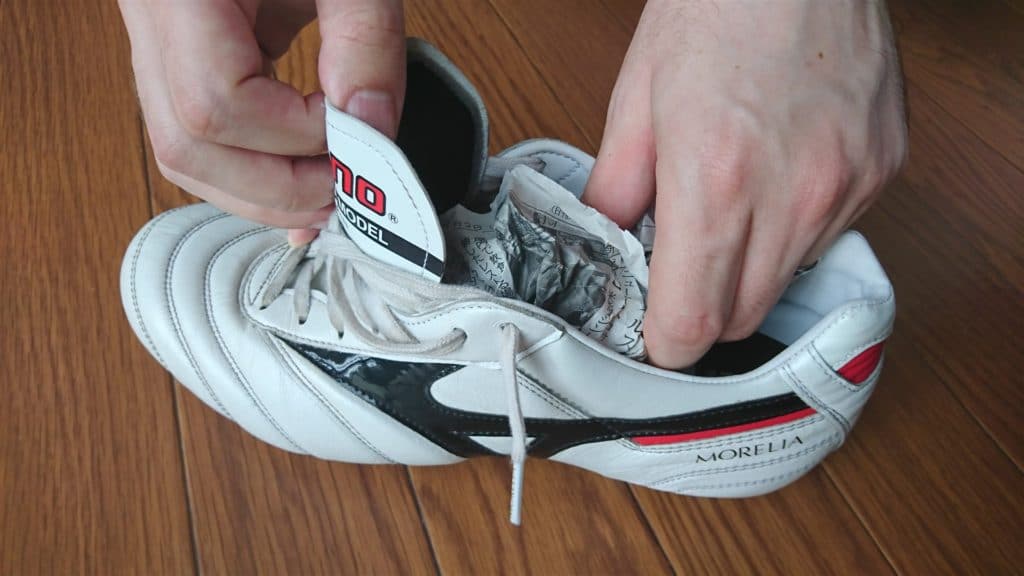Get your football boots ready for game time after lockdown.
We’ve all been waiting for what seems like forever to step back out onto the pitch. The freedom and excitement that will come will be a joy and a relief at the same time. But imagine, finally getting back out there, and you pull your boots out of the bag and… oh, they’re absolutely filthy after months in the store room.
Fortunately, we have you have covered with tips to clean all manner of football boots.
Cleaning leather football boots
The way to clean leather boots is fairly simple. First, use cold water and a soft brush to get rid of the dirt and stains. I often use an old toothbrush since its great at getting into all of the nooks and crannies. Start by getting the brush wet and gently scrub the upper. You don’t want to scrub too hard across the boot since it can cause abrasion on the surface of that lovely leather.

Next, you’ll want to move onto the soleplate. Here you can scrub a lot harder and use more water to go to town on the dirty areas.
After doing this, wipe the boots down with and old towel and store them in a cool, dry place. Do not leave them out under the sun since this will dry out the leather and greatly decrease the lifecycle of the boots.
When the boots are dry, use some leatherfood, a leather conditioner, on the upper of the boot. These can be found online at places like Amazon and eBay and I’d recommend Chelsea or Manchester Leatherfood. When putting on leatherfood, put a small amount on the upper and generously rub it around the boot with an old towel or another soft brush.

For those who are thinking of using mink oil, you may skip this step as brands have infused elements of this during production to give the leather a plush, healthy feel.
Cleaning older synthetic uppers
Wearing classic boots has become a popular trend these days. With all of the resellers that are currently around, it has never been easier to grab a classic Nike CTR 360 Maestri or an old pair of Nike Hypervenom Phantoms. For the most part, more than a few of these boots still hold up today. But when it comes to cleaning them, extra care is required.
The first thing you want to do when cleaning a pair of boots with older synthetic uppers to check for any cracking or flaking of the material on the upper. If you happen to find any flakes or cracks, do not wear these for matches.
Wearing them will only exacerbate the issue but will cause the boots to tear up easier. With tears, they can also result in a loss of support in the upper that could lead to injury. The best case scenario would be to retire those boots.
If you do not spot any issues, then cleaning the upper will be similar to what you would do with a pair of leather boots. Run some cold water and use a soft brush to remove dirt. Do the same with the soleplate.
Since synthetic boots tend to get a lot of noticeable scrapes and scuff marks on them, using a magic eraser is a good way to help get some of these scuff marks off. Again, using cold water is best since warm or hot water can lead to damage on the upper. The magic eraser might not eliminate all the scuff marks but it’ll do a respectable job to restore the look on your boot’s upper.
Cleaning knitted uppers
And now to the most popular type of boot around these days, the knitted upper.
Check and see if there are any loose threads on the upper of the boot or if there are any places where the finish is beginning to wear away. Obviously, there isn’t much you can do in terms of cleaning these parts, but it is a good idea to keep an eye on these sections since those are high risk zones where you can expect wear and tear.
Some people might be tempted to use scissors to “clean up” these threads by cutting it close to the point of fray. However, this is a very bad idea, especially if the threads are loose and connected to the boot, as there is a good chance you can tear up or weaken the boot by removing the threads this way. It’s best to leave them alone.
It would also be a good idea to not wash them with water since knit does have a tendency to absorb water easier than a “normal” synthetic would. Therefore, I’d recommend cleaning with a soft brush and a little bit of water. Finally, avoid using soap during this process as the soap’s chemicals might wear off any coated materials or finishes on the upper.
Other useful football boot cleaning tips
When removing your boots out of storage, slowly flex the soleplate to make sure there are no cracks and/or splits in the soleplate. The same goes for checking the insole board for these break downs in structure. Any cracks would mean that the materials are eroding and may break down during a game.

When wearing your football boots for the first time in months, go for a light jog and do some light touches with a ball before pushing through with more intense movements. That way the boots get “used” to the flexing of your feet progressively.
Do not attempt the hot water trick, which involves dipping your boots in hot water and then wearing them on your feet while wet and hot. The idea is for the upper to soften and mould around your feet but this not only weakens the material and destroys the finish on the upper but it also helps break down the glue that holds the upper with the soleplate.
After your first session in your football boots, put newspaper inside them so that it absorbs the moisture and any odours. This also allows the boots to dry out naturally and avoid leaving them in the sun as the direct heat will make the boots stiffer and cause the upper material to wear out quicker.

Lastly, always keep your boots clean after every game as buildup of dirt and turf debris will shorten the lifespan of your boots.
Know any other ways to clean football boots? Let us know in the comments below.
Featured image: adidas.com



